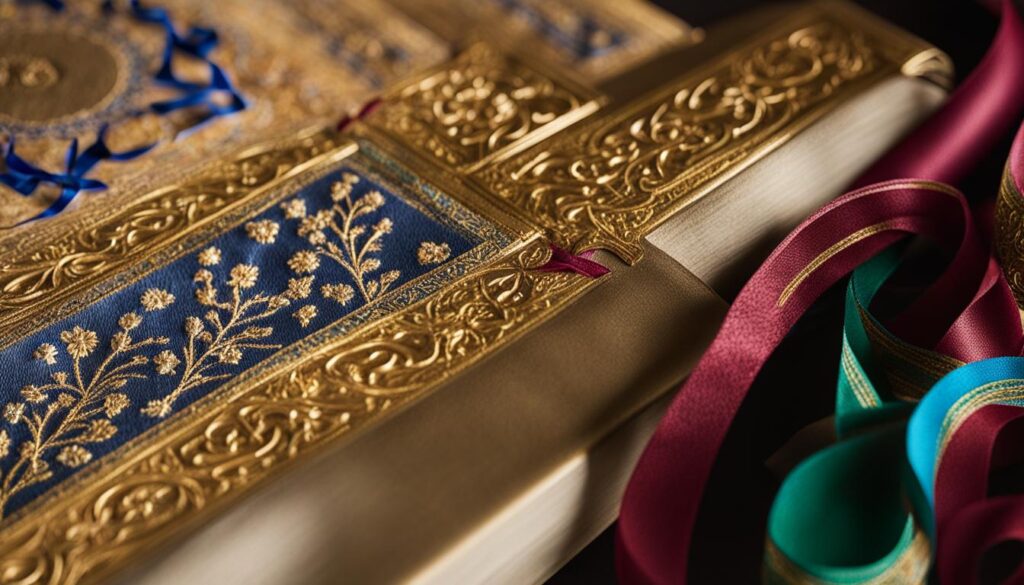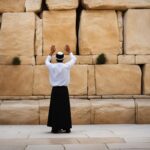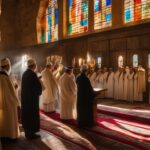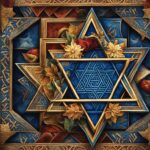The Siddur, also known as the Prayer Book, is a powerful tool that allows individuals to deepen their spiritual connection. Whether you are embarking on a spiritual journey or seeking inner peace, the Siddur offers a profound experience of divine connection.
The Siddur serves as a guide for daily prayers and special occasions in Jewish worship. It provides a structured framework that helps individuals connect with God on a personal level. Through its prayers and blessings, the Siddur allows for a deeply personal and meaningful experience of spirituality.
Symbolically, the Siddur represents the collective prayers and aspirations of the Jewish community. It serves as a vessel for expressing gratitude, hope, and devotion. The Siddur is a tangible representation of the spiritual connection between individuals and God.
While the core elements of the Siddur remain consistent across Jewish traditions, there may be variations in specific prayers and blessings among different sects. These variations reflect the diverse practices within Judaism and add richness to the spiritual experience of using the Siddur.
Materials used in the creation of the Siddur can vary. It can be made from leather, fabric, or paper. The Siddur is often beautifully bound and decorated to reflect the sacredness of its contents.
Over time, the Siddur has evolved and grown, with prayers and blessings being compiled, curated, and organized into a structured framework. Its origins can be traced back to the time of the Second Temple in Jerusalem.
In addition to the main prayers, the Siddur also includes lesser-known tools such as the Birkat Hamazon (blessings after meals) and Tefillat Haderech (prayer for travel). These tools offer additional ways to connect with God and uphold Jewish traditions.
The Siddur has also found a place in modern worship practices, as Messianic believers have embraced and adapted it to bridge the gap between Jewish tradition and belief in the Messiah. This integration allows for a contemporary spiritual experience while maintaining a connection to the rich history of the Siddur.
Using the Siddur for personal prayer enables individuals to forge a deeply personal connection with God while upholding tradition. It provides guidance, reflection, and a pathway to spiritual growth.
Begin your transformative journey today by exploring the profound spiritual depth of the Siddur. Unlock divine connection and achieve inner peace as you embrace the power of this cherished Prayer Book.
Key Takeaways:
- The Siddur is a powerful tool for deepening spiritual connection.
- It serves as a guide for daily prayers and special occasions in Jewish worship.
- The Siddur symbolizes the collective prayers and aspirations of the Jewish community.
- There may be variations among sects in specific prayers and blessings.
- The Siddur can be made from various materials, such as leather, fabric, or paper.
- Over time, the Siddur has evolved and grown, with prayers and blessings being compiled, curated, and organized.
- In addition to the main prayers, the Siddur includes lesser-known tools such as Birkat Hamazon and Tefillat Haderech.
How the Siddur is Used in Practice
The Siddur, a sacred prayer book, holds a significant role in Jewish worship and practice. It serves as a guide for prayer rituals, helping individuals connect with God on a personal level. Whether used during daily prayers or special occasions, the Siddur provides a structured framework that allows worshippers to express gratitude, seek guidance, and deepen their spiritual connection.
As individuals engage in prayer using the Siddur, they follow a prescribed order of prayers, blessings, and readings. This helps create a sense of unity and community among worshippers, as they collectively voice their hopes, aspirations, and devotion.
While the core elements of the Siddur remain consistent, there may be slight variations in specific prayers and blessings among different Jewish sects. These variations reflect the distinct traditions and customs within the diverse landscape of Jewish worship.
The materials used for the Siddur can vary, with options including leather, fabric, or paper. The intricate design and craftsmanship often reflect the sacredness of its contents, further enhancing the spiritual experience.
Over time, the Siddur has evolved alongside Jewish history and worship practices. From its origins during the time of the Second Temple in Jerusalem to its modern-day adaptations, the Siddur has witnessed changes, additions, and organization of prayers, adapting to the needs of worshippers.
In addition to the main prayers, the Siddur also includes lesser-known tools that serve specific purposes. These include the Birkat Hamazon, which encompasses blessings recited after meals, and Tefillat Haderech, a prayer for safe travel.
Key Takeaways:
- The Siddur is a guide for prayer rituals in Jewish worship
- It helps individuals connect with God on a personal level
- There may be variations in prayers and blessings among different Jewish sects
- The Siddur can be made from materials such as leather, fabric, or paper
- It has evolved over time and adapted to the changing needs of worshippers
Symbolism of the Siddur
The Siddur, also known as the Prayer Book, holds deep symbolic significance in Jewish worship. It represents the spiritual connection between individuals and God, serving as a vessel for expressing gratitude, hope, and devotion. The Siddur embodies the collective prayers and aspirations of the Jewish community, offering a profound sense of unity and shared faith.
Each prayer in the Siddur carries its own symbolism, reflecting different aspects of the Jewish faith. The Shema, for example, is a central prayer that proclaims the unity of God and calls for unwavering love and commitment. The Amidah, also known as the “Standing Prayer,” is a time of personal connection and reflection, allowing individuals to express their most intimate hopes and desires to the Divine.
The Siddur is not merely a compilation of words, but rather a pathway to spiritual connection and inner transformation.
Furthermore, the Siddur serves as a guide for spiritual growth, providing a structured framework for prayer and meditation. It invites individuals to embark on a journey of self-discovery and introspection, nurturing their relationship with God and fostering a deeper understanding of themselves.
The Power of Ritual
By engaging in the prayers and rituals outlined in the Siddur, individuals can connect with the rich history and tradition of Judaism. The repetition of these timeless words and gestures creates a sacred rhythm, setting the stage for divine encounters and moments of profound revelation. Through the Siddur, the individual becomes part of a timeless chain, linking past, present, and future generations in a tapestry of spiritual connection.
Ultimately, the Siddur is not merely a compilation of words, but rather a pathway to spiritual connection and inner transformation. It serves as a reminder of the power and beauty of prayer, guiding individuals on their journey towards a deeper understanding of themselves, their faith, and their relationship with God.
| Symbolism of the Siddur | Meaning |
|---|---|
| The Shema | Proclaims the unity of God and calls for unwavering love and commitment. |
| The Amidah | Allows individuals to express their most intimate hopes and desires to the Divine. |
| The Power of Ritual | Engaging in prayers and rituals creates a sacred rhythm, setting the stage for divine encounters. |
| A Pathway to Transformation | The Siddur guides individuals on a journey of self-discovery and nurtures their relationship with God. |
Variations Among Sects
When it comes to the Siddur, the prayer book used in Jewish worship, there are certain core elements that remain consistent across different sects. However, variations can be found in specific prayers and blessings, reflecting the unique traditions and customs of each sect.
One notable variation among sects is the inclusion of additional prayers or the omission of certain prayers in their Siddur. For example, some sects may have distinct prayers for specific occasions or festivals that are not found in other versions of the Siddur. These variations highlight the diverse ways in which different Jewish communities express their devotion and connection to God through prayer.
“The variations among sects in the Siddur texts and rituals are a testament to the richness and complexity of Jewish worship. They showcase the diverse ways in which individuals and communities engage with prayer and connect with the divine.”
Another area of variation lies in the language used within the Siddur. While Hebrew is the predominant language, certain sects may incorporate prayers or blessings in other languages, such as Yiddish or Ladino, to reflect the historical and cultural backgrounds of their respective communities.
| Sect | Variations in Siddur |
|---|---|
| Orthodox | Includes additional prayers and blessings specific to Orthodox traditions. |
| Conservative | Adapts the Siddur to reflect more egalitarian practices, incorporating gender-neutral language and alternative blessings. |
| Reform | Emphasizes personal interpretation and creativity, allowing for more flexibility in the Siddur and the inclusion of contemporary readings or poems. |
These variations in the Siddur not only highlight the rich tapestry of Jewish worship but also allow individuals and communities to find a connection to prayer practices that resonate with their beliefs and traditions.
Materials Used for the Siddur
The Siddur, as a sacred and cherished item, is crafted with utmost care and reverence. Various materials are used to create these prayer books, reflecting the significance they hold within Jewish worship. From fine leather to delicate fabric and durable paper, each material offers its own unique qualities and contributes to the overall beauty and functionality of the Siddur.
Leather, known for its durability and timelessness, is often used for the cover of the Siddur. It provides a sense of elegance and longevity, symbolizing the enduring nature of prayer and spiritual connection. Leather-bound Siddurs are cherished heirlooms and are often passed down through generations, carrying with them the stories and devotion of those who have used them before.
For those who prefer a more tactile experience, fabric-bound Siddurs provide a delicate and ornate option. These prayer books are often adorned with intricate embroidery or embellishments, adding a touch of artistry to the worship experience. Fabric-bound Siddurs offer a unique sensory experience, combining visual beauty with a soft and comforting texture.
Paper-bound Siddurs, on the other hand, offer a lightweight and easily accessible option. They are often used for mass-produced prayer books that are widely available to the Jewish community. While paper may not possess the same luxurious qualities as leather or fabric, it is a practical choice that allows for easy portability and affordability.

“The choice of materials for the Siddur reflects the reverence and importance we place on prayer. Whether it is the durability of leather, the beauty of fabric, or the practicality of paper, each material serves to enhance our worship experience and connect us to the divine.”
The materials used for the Siddur not only contribute to its physical aspects but also play a significant role in creating a sacred atmosphere during prayer. The choice of material is a personal one, allowing individuals to connect with their own spirituality and preferences. Whether it is the warmth and familiarity of a leather-bound Siddur or the delicacy and artistry of a fabric-bound one, the materials used for the Siddur serve as a reminder of the power and beauty of prayer.
| Material | Characteristics |
|---|---|
| Leather | Durable, timeless, symbolizes endurance |
| Fabric | Delicate, ornate, offers tactile experience |
| Paper | Lightweight, easily accessible, portable |
Evolution of the Siddur Over Time
The Siddur, a precious compilation of prayers and blessings, has undergone significant evolution throughout history. Its development spans centuries, tracing back to the time of the Second Temple in Jerusalem. Over time, prayers and blessings were carefully curated, organized, and added to the Siddur, reflecting the spiritual needs and aspirations of the Jewish community.
Throughout various historical periods, the Siddur evolved to incorporate new prayers and adaptations, mirroring the changing dynamics of Jewish worship. One significant milestone in the Siddur’s evolution was the compilation of the Babylonian Talmud, which influenced the inclusion of additional blessings and prayers. This compilation, completed in the 6th century CE, solidified the foundation of the Siddur as an essential guide for Jewish prayer.
As the diaspora unfolded and Jews dispersed across different regions, the Siddur continued to evolve, showcasing regional variations and cultural influences. These adaptations provided a sense of belonging and familiarity for Jewish communities in different parts of the world. Notable variations include the Ashkenazi, Sephardic, and Mizrahi Siddurim, each reflecting the unique customs, traditions, and pronunciations of the respective Jewish communities.
| Period | Key Development |
|---|---|
| Second Temple Period | Origins of the Siddur as prayers and blessings were orally transmitted |
| 6th century CE | Compilation of the Babylonian Talmud influences the structure and content of the Siddur |
| Medieval Period | Regional variations in the Siddur emerge, reflecting cultural influences |
| Modern Era | Adaptation of the Siddur to accommodate the needs of contemporary Jewish worship |
Through centuries of evolving prayers and blessings, the Siddur has preserved the essence of Jewish spirituality and provided a framework for connecting with the Divine. Its rich historical origins and adaptations across different regions contribute to the diversity and unity of Jewish worship.
Lesser-Known Tools in the Siddur
While the Siddur is the main prayer book used in Jewish worship, it also contains several lesser-known tools that play important roles in the spiritual practice of individuals. These additional tools serve as guides for specific moments and occasions, further enhancing the connection between worshippers and the divine.
1. Birkat Hamazon (Blessings After Meals)
One of the lesser-known tools in the Siddur is the Birkat Hamazon, also known as the blessings after meals. This section of the Siddur provides a series of blessings to be recited after partaking in a meal. It acknowledges the gratitude for sustenance and encourages reflection on the nourishment of both the body and the soul.
2. Tefillat Haderech (Prayer for Travel)
Another important tool found within the Siddur is the Tefillat Haderech, which is a prayer specifically for travelers. It is recited before embarking on a journey, seeking divine protection and guidance throughout the travels. This prayer acknowledges the potential dangers and seeks divine intervention for a safe and successful journey.
These lesser-known tools in the Siddur provide worshippers with additional prayers and blessings for specific moments, enhancing their spiritual connection and allowing for a deeper engagement with Jewish tradition and worship practices.
Table: Lesser-Known Tools in the Siddur
| Tool | Purpose |
|---|---|
| Birkat Hamazon | Blessings after meals, expressing gratitude and reflection |
| Tefillat Haderech | Prayer for safe and successful travel |
These lesser-known tools within the Siddur provide worshippers with additional prayers and blessings for specific moments, enhancing their spiritual connection and allowing for a deeper engagement with Jewish tradition and worship practices.

Bringing the Siddur into Modern Worship
The Siddur, a traditional Jewish prayer book, has been embraced and adapted by Messianic believers as they seek to bridge the gap between Jewish tradition and their belief in the Messiah. In modern worship practices, the Siddur plays a vital role in guiding believers on their spiritual journey.
“The Siddur serves as a connection to our roots and heritage,” says Rabbi David Cohen, a Messianic Jewish leader. “By incorporating the Siddur into our worship, we are able to honor our Jewish identity while expressing our faith in Yeshua.”
For Messianic believers, the Siddur offers a structured framework for prayer and worship, providing a sense of continuity with the Jewish community. It allows them to engage with the rich history of Jewish prayers and blessings, while also infusing their worship with a personal connection to the Messiah.
Integrating Tradition and Belief
The Siddur provides Messianic believers with a way to integrate their Jewish heritage and traditions with their belief in Yeshua (Jesus). By incorporating elements of the Siddur into their worship, they are able to honor their Jewish roots and express their faith in the Messiah.
| Siddur | Modern Worship |
|---|---|
| Traditional prayers | Adaptation of traditional prayers to reflect Messianic beliefs |
| Structured framework | Provides a framework for worship and personal connection |
| Collective experience | Individual and communal expressions of faith |
| Rich history | Continuity with Jewish traditions and the Messiah |
By incorporating the Siddur into their worship, Messianic believers are able to tap into the spiritual depth of the Jewish prayer book while infusing it with their own beliefs and experiences. This unique blend of tradition and faith creates a meaningful and transformative worship experience.
As Messianic believers continue to explore their spiritual journey, the Siddur remains a valuable tool, helping them connect with both their Jewish heritage and their belief in the Messiah. It serves as a bridge between the past and the present, allowing for a vibrant and relevant worship experience.

Personal Connection and the Siddur
The Siddur, also known as the Jewish prayer book, serves as a powerful tool for establishing a personal connection with the divine. Its pages are filled with prayers, blessings, and sacred texts that guide individuals in their spiritual journey. By engaging with the Siddur, worshippers can forge a deep and meaningful bond with God while upholding tradition.
Through the Siddur, individuals have the opportunity to express their deepest thoughts, emotions, and desires in the form of prayer. This act of communication allows for a personal and intimate connection with the Divine, fostering a sense of closeness and understanding. The Siddur acts as a guide, providing structure and guidance for those seeking to deepen their spiritual connection.
“The Siddur is not just a collection of words; it is a pathway to the soul. It is through the Siddur that we can express our deepest yearnings and find solace in times of joy or sorrow.” – Rabbi David Cohen
Additionally, the Siddur acts as a vehicle for self-reflection and spiritual growth. As individuals engage in prayer, they are prompted to contemplate their values, aspirations, and relationship with God. The Siddur offers a space for introspection and contemplation, allowing worshippers to gain insights into themselves and their spiritual journey.
Furthermore, the Siddur serves as a bridge between generations, connecting individuals to their ancestors and the collective history of the Jewish people. It provides a sense of continuity and unity, as prayers and blessings are recited in the same manner as they have been for centuries. This connection to tradition and community enhances the personal connection experienced through the Siddur.
The Power of Personal Connection
When individuals engage with the Siddur, they tap into a wellspring of spiritual energy and wisdom. The prayers and rituals contained within its pages have been carefully curated over time to facilitate a transformative experience. Whether reciting the morning blessings, the Shema, or the Amidah, the Siddur offers a framework for connecting with the divine and embarking on a personal journey of growth and enlightenment.
| Benefits of Personal Connection with the Siddur |
|---|
| Enhanced spiritual awareness: The Siddur guides individuals in accessing deeper levels of spiritual awareness, allowing for a heightened sense of connection with God. |
| Emotional well-being: Engaging with the Siddur can promote emotional well-being by providing a space for reflection, gratitude, and finding solace in times of difficulty. |
| Strengthened faith: Through regular engagement with the Siddur, individuals can strengthen their faith and cultivate a deeper trust in God’s guidance and providence. |
| Community connection: The collective experience of engaging with the Siddur connects individuals to the greater Jewish community, fostering a sense of unity and shared purpose. |
The Siddur serves as a faithful companion on the spiritual journey, guiding individuals towards personal growth, connection, and a deeper understanding of their relationship with God. By embracing the Siddur and weaving its teachings into our daily lives, we can unlock the transformative power of prayer and experience a profound and lasting personal connection with the divine.

Conclusion
The Siddur, a powerful tool in Jewish worship, offers a profound spiritual connection and guidance for individuals on their spiritual journey. Through its rich history and symbolic significance, it serves as a treasured companion in the quest for inner peace and divine connection.
Used in practice, the Siddur provides a structured framework for daily prayers and special occasions, allowing individuals to connect with God on a personal level. It represents the collective hopes, aspirations, and gratitude of the Jewish community, fostering a sense of unity and devotion.
While the core elements of the Siddur remain consistent across Jewish traditions, there may be variations in specific prayers and blessings among different sects. These variations reflect the diverse practices and beliefs within Judaism, allowing for a nuanced exploration of the spiritual journey.
Constructed with care, the Siddur can be made from various materials, such as leather, fabric, or paper, reflecting the sacredness of its contents. Its physical beauty further enhances the spiritual experience, creating a sense of reverence and awe.
Having evolved over centuries, the Siddur continues to adapt and resonate with worshippers in the modern age. Its versatility has been embraced by Messianic believers, bridging Jewish tradition with their belief in the Messiah.
Alongside the Siddur, lesser-known tools like the Birkat Hamazon (blessings after meals) and Tefillat Haderech (prayer for travel) enhance the worship experience, providing additional opportunities for connection and reflection.
Embark on your own transformative journey with the Siddur, allowing it to guide you in deepening your spiritual connection with God. Its enduring significance and adaptable nature continue to make it a cherished companion on the path to spiritual growth and inner peace.
FAQ
What is the Siddur?
The Siddur is a prayer book used for daily prayers and special occasions in Jewish worship.
How is the Siddur used in practice?
The Siddur provides a structured framework for prayer rituals and helps individuals connect with God on a personal level during worship.
What is the symbolism of the Siddur?
The Siddur symbolizes the spiritual connection between individuals and God, representing the collective prayers and aspirations of the Jewish community.
Are there variations among different sects in the Siddur?
Yes, there may be slight variations in prayers and blessings among different sects within Judaism.
What materials are used for the Siddur?
The Siddur can be made from various materials, including leather, fabric, or paper, often beautifully bound and decorated.
How has the Siddur evolved over time?
The Siddur has evolved over centuries, with prayers and blessings being compiled, curated, and organized into a structured framework since the time of the Second Temple in Jerusalem.
Are there other tools included in the Siddur?
Yes, the Siddur includes other tools such as the Birkat Hamazon (blessings after meals) and Tefillat Haderech (prayer for travel).
How is the Siddur incorporated into modern worship?
Messianic believers have embraced and adapted the Siddur to modern worship practices, bridging the gap between Jewish tradition and belief in the Messiah.
How does the Siddur help with personal connection?
The Siddur serves as a tool for personal prayer, allowing individuals to forge a deeply personal connection with God while upholding tradition.
What is the significance of the Siddur in the spiritual journey?
The Siddur holds immense power in fostering a deeper connection with God, offering guidance, reflection, and spiritual growth in one’s quest for inner peace.








